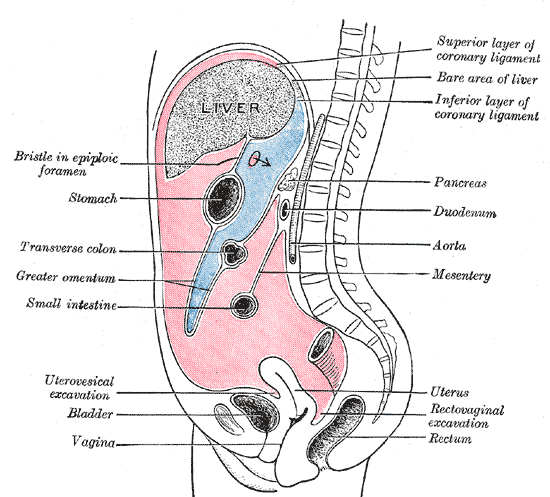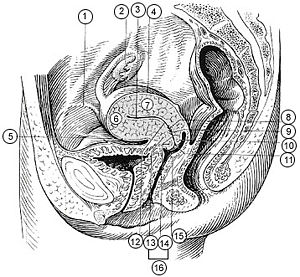Rectouterine pouch
Editor-In-Chief: C. Michael Gibson, M.S., M.D. [1]
The rectouterine pouch (or rectouterine excavation, or rectovaginal) is the extension of the peritoneal cavity between the rectum and back wall of the uterus in the female human body.
In women it is the deepest point of the peritoneal cavity, posterior to (behind) the uterus and anterior to (in front of) rectum. (The pouch on the other side of the uterus is the vesicouterine excavation.)
It is near the posterior fornix of the vagina.
In men, the region corresponding to the rectouterine pouch is the Rectovesical excavation, which lies between the urinary bladder and rectum. (There is no equivalent to the vesicouterine excavation.)
Pathology
The rectouterine pouch, being the lowest part of the peritoneal cavity in a woman who is standing, is a common site for the spread of pathology such as ascites, tumour, endometriosis, pus, etc.
Naming/Etymology
It is also known by the names Douglas pouch, Douglas space, Douglas cul-de-sac.[1]
It is named after the Scottish anatomist Dr James Douglas (1675–1742) who extensively explored this region of the female body. Three other nearby anatomical structures are also named for him - the Douglas fold, the Douglas line and the Douglas septum.
Additional images
-
The epiploic foramen, greater sac or general cavity (red) and lesser sac, or omental bursa (blue).
-
Illu female pelvis
References
External links
- Template:EMedicineDictionary
- Template:SUNYAnatomyLabs - "The Female Pelvis: Distribution of the Peritoneum in the Female Pelvis"
- Template:SUNYAnatomyImage
- Template:SUNYAnatomyImage
- Douglas'+Pouch at the US National Library of Medicine Medical Subject Headings (MeSH)
- Template:NormanAnatomy
- Template:DartmouthHumanAnatomy
- Template:RocheLexicon

